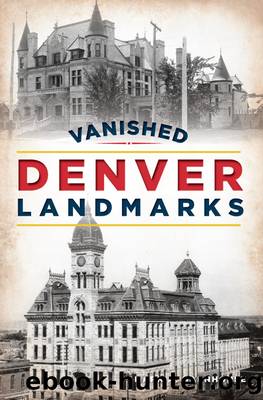Vanished Denver Landmarks by Mark A. Barnhouse

Author:Mark A. Barnhouse [Barnhouse, Mark A.]
Language: eng
Format: epub
Tags: Architecture, Buildings, Landmarks & Monuments, History, United States, State & Local, West (AK; CA; CO; HI; ID; MT; NV; UT; WY)
ISBN: 9781439673942
Google: -SBDEAAAQBAJ
Publisher: Arcadia Publishing
Published: 2021-10-11T02:44:41+00:00
COTTRELLâS
Decades after its namesake business closed, âCottrellâs, the mans storeâ signage graced the second floor of a rundown-looking building at 16th and Welton Streets. Many of its customers had retired or died by the time it came down in 2020, but for nearly a century, Cottrellâs reigned as a leading menswear shop. George F. Cottrell (âCOTT-rulâ) came to Denver from Providence, Rhode Island, in 1890 at age twenty-seven, seeking relief from chronic hay fever. A clothing salesman with fifteen yearsâ experience, he found work at a Larimer Street emporium that sent him traveling through mountain towns. In Leadville, he encountered a ânoted mining manâ who wanted silk shirts. Cottrell, when asked the price, told him twenty-five dollars, and the wealthy miner bought twoâwhen their price in Providence was only one dollar. His employer kept him on.
On Friday, July 23, 1893, walking up 16th Street, Cottrell encountered a bankrupt menâs store between California and Welton Streets. July was the peak of the 1893 Panic; stores were desperate for cash. On this same day, four banks failed; that summer, more than half of Denverâs banks closed. Cottrell saw opportunity: Daniels and Fisher department store, the shopâs major creditor, had taken over and was selling stock and fixtures for $750 in cash. Cottrell negotiated with the manager, reducing that to $675, and went to his bank to withdraw funds. The bank said he could have it after a ninety-day wait, so he went to the wealthiest man he knew, flour millionaire John Kernan Mullen, and explained his predicament. Mullen took him to visit William Garrett Fisher at his store. Fisher would not sell the shop on a promise of future cash but accepted Mullenâs âpersonal note,â and Cottrell Clothing Company was born.
Denverâs wealthy became regular patrons, with Cottrell selling suits and hats to Henry Cordes Brown, Senator Henry Moore Teller and Senator Thomas Patterson. Yet he also catered to humbler types; in 1936, he told the Colorado Labor Advocate he âattribute[d] a large part of his success to the support of union men.â The shop, enlarged several times, remained in the Crandall Block at 16th and Welton Streets until a 1912 fire; it reopened in the Mack Block across the alley. Cottrell died in 1938, and his widow, along with longtime employees H.A. Rodecker and William E. Glass, kept Cottrellâs going. In 1948, anticipating Denverâs growth and needing to vacate the scheduled-for-demolition Mack Block, Rodecker and Glass signed a lease in the Liebhardt Building, a two-story structure built in 1915 in place of the burned Crandall Block. When the new Cottrellâs opened in 1950, it occupied all of the fully remodeled, twenty-eight-thousand-square-foot structure, now with an elegant Modernist façade of dark Virginia greenstone trimmed with aluminum. The street level featured showcase windows for passersby, while large second-floor windows allowed ample light to illuminate Cottrellâs vast suit selection. The interior had a masculine, clubby feeling, with tan and brown on the first floor and green on the second, with light oak fixtures. Escalators connected the floors, and over eighty employees assisted customers.
Download
This site does not store any files on its server. We only index and link to content provided by other sites. Please contact the content providers to delete copyright contents if any and email us, we'll remove relevant links or contents immediately.
Kathy Andrews Collection by Kathy Andrews(11730)
The remains of the day by Kazuo Ishiguro(8825)
Paper Towns by Green John(5091)
Spare by Prince Harry The Duke of Sussex(5072)
Industrial Automation from Scratch: A hands-on guide to using sensors, actuators, PLCs, HMIs, and SCADA to automate industrial processes by Olushola Akande(4984)
The Body: A Guide for Occupants by Bill Bryson(4974)
Machine Learning at Scale with H2O by Gregory Keys | David Whiting(4183)
Be in a Treehouse by Pete Nelson(3950)
Never by Ken Follett(3794)
Harry Potter and the Goblet Of Fire by J.K. Rowling(3775)
Goodbye Paradise(3728)
Into Thin Air by Jon Krakauer(3313)
The Remains of the Day by Kazuo Ishiguro(3294)
The Cellar by Natasha Preston(3262)
The Genius of Japanese Carpentry by Azby Brown(3226)
Fairy Tale by Stephen King(3220)
120 Days of Sodom by Marquis de Sade(3182)
The Man Who Died Twice by Richard Osman(2997)
Drawing Shortcuts: Developing Quick Drawing Skills Using Today's Technology by Leggitt Jim(2996)
